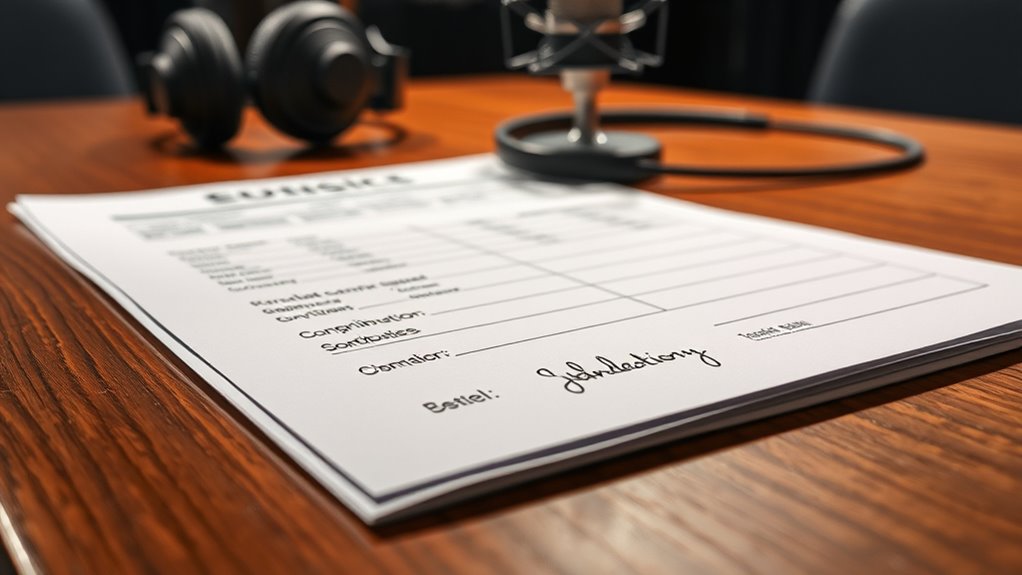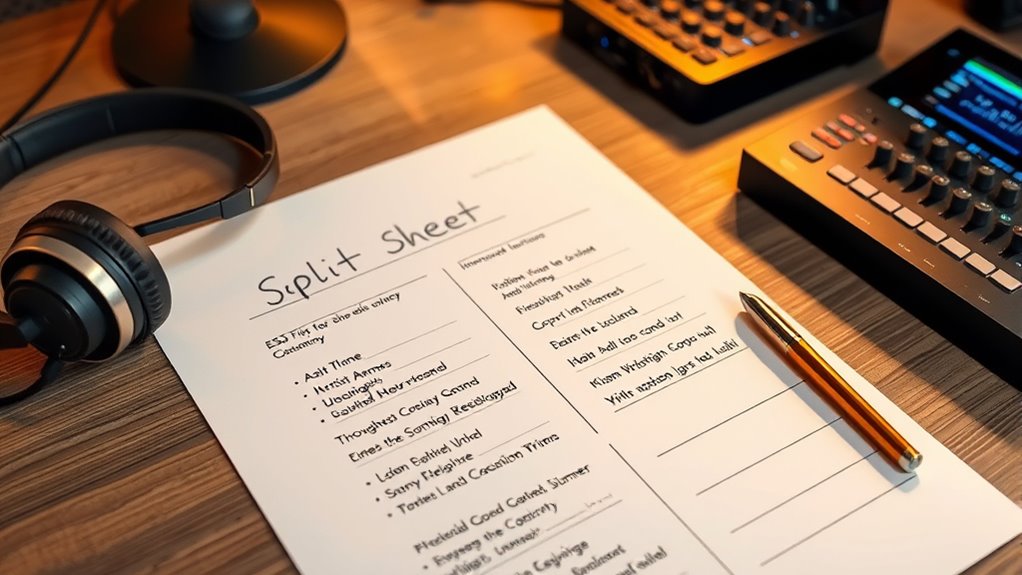To avoid royalty disputes, start with a clear, detailed split sheet that lists all contributors, ownership percentages, and the scope of rights. Use specific language, include signatures, and update it regularly to reflect changes. Confirm everyone understands and agrees on each point before finalizing. Keeping thorough records and open communication helps prevent misunderstandings. Want more tips to secure your rights and avoid conflicts? Keep going for practical advice.
Key Takeaways
- Use clear, specific language to define ownership percentages, roles, and responsibilities from the outset.
- Include all collaborators’ signatures, dates, and project details to ensure mutual understanding and enforceability.
- Regularly update the split sheet with any new contributions or changes to maintain accurate documentation.
- Clarify scope, duration, and territory explicitly to prevent misunderstandings over rights and revenue.
- Review and communicate openly with all parties to ensure everyone agrees and is aware of their rights and obligations.
Understanding the Purpose and Importance of Split Sheets

Understanding the purpose and importance of split sheets is essential for anyone involved in music collaboration. A split sheet serves as a written agreement that clearly states each contributor’s share of ownership and royalties for a song. It helps prevent misunderstandings or disputes down the line, ensuring everyone knows their rights upfront. By documenting who wrote what and how revenue is split, you protect yourself and your collaborators. Without a split sheet, you risk losing control over your earnings or facing disagreements that can delay or even derail your project. It’s a simple but crucial step in professional music making. Having a clear, signed split sheet creates transparency, fosters trust, and makes royalty collection smoother for everyone involved. Additionally, understanding music genres and roles can help tailor the split sheet to reflect the specific contributions of each collaborator more accurately. Recognizing the significance of fathers’ influence and support in creative projects can also enhance the collaborative process by emphasizing mutual respect and shared goals. Proper documentation procedures are vital to ensure that all legal and financial aspects are properly managed from the start, preventing potential disputes over ownership.
Key Elements to Include in a Split Sheet

When preparing a split sheet, including the right key elements guarantees all parties are on the same page. You need clear, specific details to prevent misunderstandings later. Essential elements include song title, writer names, and ownership percentages. Be sure to add the date and the effective start date of the split. Signatures from all parties confirm agreement. Here’s a quick overview:
| Element | Purpose |
|---|---|
| Song Title | Identifies the work clearly |
| Writer Names | Names all contributing songwriters |
| Ownership Percentages | Defines each party’s share |
| Signatures | Legally confirms agreement |
| Date | Establishes when the split was agreed upon |
Including these ensures transparency and protects everyone involved. Additionally, understanding the importance of accurate ownership percentages can help prevent future disputes over rights and royalties. Accurately documenting ownership ensures fair distribution and reduces potential conflicts. Clarifying the distribution method can also help avoid confusion over how royalties are divided, especially in a digital environment where online sharing is common.
Best Practices for Drafting and Signing Split Sheets

To guarantee your split sheet is effective and enforceable, you should follow best practices when drafting and signing it. Use clear, specific language to outline each party’s share and responsibilities. Include essential details like project title, date, and signatures from all involved parties. Avoid vague terms or ambiguous language that could lead to disputes later. Both parties should review the document carefully before signing to ensure accuracy and understanding. Signatures should be handwritten or digitally verified to confirm agreement. Keep multiple copies, and store them securely. If possible, have a neutral witness or notarization to bolster enforceability. Following these practices helps create a solid, reliable split sheet that minimizes misunderstandings and legal challenges down the line.
Common Pitfalls and How to Avoid Them

One common pitfall in creating split sheets is using vague or ambiguous language, which can lead to misunderstandings or disputes later on. To avoid this, be precise when describing your rights, percentages, and responsibilities. Use clear terms and define any technical language or abbreviations upfront. Overlooking details like the scope of use, duration, or territory can cause confusion down the line. Additionally, neglecting to get all parties to review and agree in writing increases the risk of disagreements. Remember, assumptions can be dangerous. Always double-check that everyone’s understanding aligns and document every detail thoroughly. Being aware of potential AI security vulnerabilities and having a plan to maintain organization can help keep these agreements clear and manageable. Clarifying contractual obligations ensures that all parties are aware of their responsibilities from the outset. Understanding the importance of security measures can also prevent inadvertent breaches or misunderstandings. By being specific and transparent from the start, you reduce the chances of disputes and create a solid foundation for fair collaboration.
Implementing Ongoing Documentation and Communication

Implementing ongoing documentation and communication is essential to maintaining clarity and preventing misunderstandings throughout a project. You should regularly update your split‑sheet with new contributions, changes, or agreements, so everyone stays on the same page. Use clear, written records—emails, meeting notes, or shared documents—to track decisions and responsibilities. Encourage open dialogue, so team members can clarify doubts early. Consistent communication helps catch potential disputes before they escalate. Make sure all parties agree on updates and understand their implications. Establishing a routine for documentation and dialogue helps create a record that can be referenced if questions arise later. Incorporating clear communication channels ensures that information flows smoothly among team members. Regularly reviewing your split‑sheet ensures that all contributors are aligned and that any discrepancies are addressed promptly. This proactive approach helps ensure transparency and trust within the team, reducing the likelihood of misunderstandings that could lead to disputes.
Frequently Asked Questions
How Often Should Split Sheets Be Reviewed and Updated?
You should review and update your split sheets regularly to prevent disputes and guarantee accuracy. Ideally, do this whenever there’s a change in song ownership, collaborators, or revenue sharing terms. At minimum, check your split sheets annually or after major projects. Staying proactive keeps everyone informed and protected, reducing the chance of misunderstandings over royalties. Consistent updates help maintain transparency and trust among all parties involved.
What Are the Legal Implications of Not Using a Split Sheet?
You might think skipping a split sheet is harmless, but the legal implications are serious. Without it, you risk losing your rights, facing costly disputes, or ending up with nothing if disagreements escalate. Not having clear, written agreements leaves you vulnerable to misunderstandings and legal battles. In fact, neglecting this simple step can turn your creative collaboration into a legal nightmare, all because you overlooked the importance of clarity upfront.
Can Split Sheets Be Used for Multiple Collaborators?
Yes, you can use split sheets for multiple collaborators. They help clearly define each person’s contribution and ownership share, preventing future disputes. You simply list all involved parties, specify their respective rights, and get everyone to sign. This way, everyone knows their rights upfront, making royalty distribution smoother. Just guarantee the split sheet is detailed, accurate, and signed by all collaborators to protect everyone’s interests.
How Do Split Sheets Differ Across Various Entertainment Industries?
You’ll find that split sheets differ across entertainment industries because each has unique norms and legal standards. In music, they detail songwriting and publishing rights, while in film and TV, they clarify contributions and royalties for scripts or production work. In gaming, they specify intellectual property rights and revenue sharing. Understanding these industry-specific differences helps you create clear agreements, reducing disputes and ensuring fair compensation for everyone involved.
What Tools or Software Can Assist in Creating Split Sheets?
Did you know that using dedicated software can reduce royalty disputes by up to 80%? When creating split sheets, tools like Songtrust, Split Sheets, and Kobalt’s studio management software help you organize and document ownership shares precisely. These platforms streamline collaboration, guarantee transparency, and make it easier to update agreements, so you avoid confusion and disputes down the line. You might find one of these tools fits your needs perfectly.
Conclusion
By mastering split-sheet essentials, you can prevent costly royalty disputes before they start. Clear documentation reduces misunderstandings—studies show that 60% of music industry conflicts stem from poor record-keeping. Staying proactive with thorough, up-to-date split sheets ensures everyone’s contributions are recognized and protected. Taking these steps now helps you build trust and avoid legal headaches down the line, so you can focus on creating great music instead of resolving disputes.










